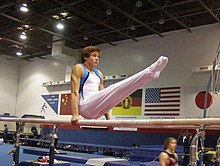

Parallel bars are floor apparatus consisting of two wooden bars approximately 350cm (11'6") long and positioned at 200 centimetres (6.6 ft) above the floor. Parallel bars are used in artistic gymnastics and also for physical therapy and home exercise. [1] Gymnasts may optionally wear grips when performing a routine on the parallel bars, although this is uncommon.